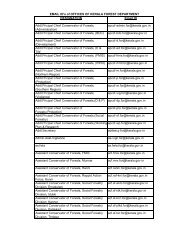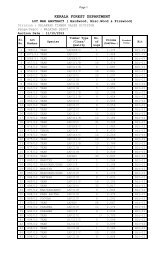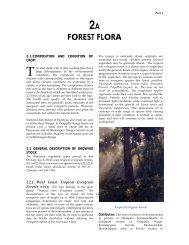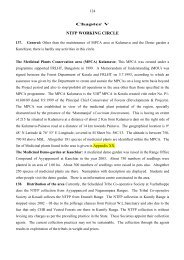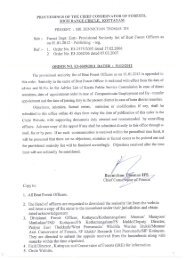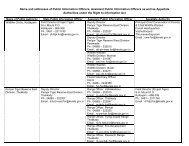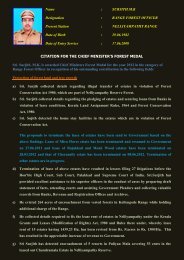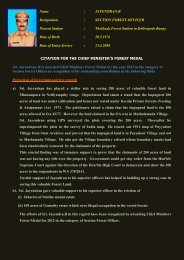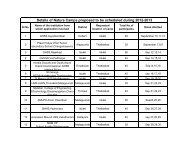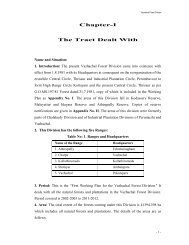Create successful ePaper yourself
Turn your PDF publications into a flip-book with our unique Google optimized e-Paper software.
PUNALUR FOREST DIVISION<br />
FLORA<br />
Composition of the Forests The diversity of species, their growth condition<br />
<strong>and</strong> other factors of the forests are governed by climatic, geographic <strong>and</strong><br />
edaphic factors. Physiognomy, biomass, species composition, floristic<br />
stratification <strong>and</strong> phenology are the various significant aspects of determining<br />
the structure of vegetation. The variation in altitudes, ruggedness of the terrain<br />
<strong>and</strong> the resultant differences in temperature <strong>and</strong> rainfall coupled with biotic<br />
<strong>and</strong> edaphic condition are responsible for the existence of many types of forests<br />
in this Division.<br />
General description of growing stock:<br />
Forest Types<br />
Approximate extent of natural forest in the division is 7,758.17 ha. In<br />
accordance with the classification of forests by Champion <strong>and</strong> Seth; four types<br />
of forests are found here. They are, (1) West coast tropical evergreen forest<br />
(1A/C4), (2) West Coast semi evergreen forest (2A/C2), (3) Southern moist<br />
mixed deciduous forest (3B/C2) <strong>and</strong> (4) Grass l<strong>and</strong>s.<br />
(1). West Coast Tropical Evergreen Forest (1A/C4) This type of forests<br />
represents the most luxuriant vegetation. Wherever it exists, it is considered as<br />
the climatic climax. The forests under this type are occasionally met in patches<br />
within the Yeroor Reserve <strong>and</strong> high slopes of Achenkovil Reserve. Because of<br />
heavy biotic interference extent of this type of forests is reduced considerably.<br />
At present, this type exists only in small isolated patches at Olappara <strong>and</strong><br />
Kuravanthavalam in Achenkovil Reserve, Ottakkal <strong>and</strong> along the river belts of<br />
Yeroor Reserve <strong>and</strong> in Hill folds of both Reserves. The natural regeneration of<br />
evergreen species is satisfactory. But due to biotic interference, the<br />
establishment of the seedlings is seen affected. The extent of this type of forest<br />
is approximately 600 ha, prevailing in patches. The Floristic composition of this<br />
type is as below: Top Canopy: The main species in the top canopy are Vateria<br />
Indica, Cedrella toona, Tetrameles nudiflora, Hardwickia pinnata, Hopea<br />
parviflora, Bishchofia javanica, Vitex altissima, Mangifera indica, Machilus<br />
macrantha, Lophopetalum weightianum, Dipterocarpus indicus etc. Lower<br />
Canopy: Cinnamomum zeylaniucm, Polyalthia fragrans, Nephelium longana,<br />
Canarium strictum, Hydnocarpus wightiana, Evodia roxburghiana.<br />
Undergrowth: Strobilanthes spp, Calamus spp, Clerodendron spp, Kora spp,<br />
Wild arrowroot etc. Climbers: Bauhinia vahlii, Entada sc<strong>and</strong>ens, Dioscorea spp.<br />
(2). West Coast Semi Evergreen Forests (2A/C2) This type of forests is<br />
confined to the areas where soil depth is more <strong>and</strong> rich in fertility. The forests
in the category are considered as a mixture of both evergreen <strong>and</strong> deciduous<br />
type of tree growth. This forms a closed forest. Such type is met with around<br />
Mambazhathara <strong>and</strong> Kottakkayam in Achenkovil Reserve <strong>and</strong> in folds of hills<br />
<strong>and</strong> higher portions in Yeroor Reserve. The natural regeneration is<br />
comparatively less, because of more biotic interference. This type of forest is<br />
approximately 400 ha the floristic composition is as below. Top Canopy:<br />
Artocarpus hirsutus, Hopea parviflora, Terminalia paniculata, Terminalia<br />
tomentosa, Lagerstroemia lanceolata, Salmalia malabarica, Tetrameles nudiflora,<br />
Vitex altissima, Vateria indica, Terminalia bellerica etc. Lower canopy: Mallotus<br />
philippinensis, Albizia odoratissima, Macaranga petata, Cinnamomum<br />
zeylaniucm, Bridelia retusa etc., Under Growth: Glycosmis pentaphyla, Butea<br />
parviflira, Dioscorea Species, Strobilanthes etc., Climbers: Entada phaseoloides,<br />
Strychnos colubrine. The tropical evergreen forests that were subjected to heavy<br />
interference have changed to this type. It is now in a transitional stage from<br />
evergreen to deciduous owing to the change environment.<br />
(3). Southern Moist Mixed Deciduous Forest (3B/C2): Major portions of the<br />
forest in this Division are of this type. Deciduous species are dominant. In the<br />
lower canopy, evergreen species are also met with. Wherever the canopy is<br />
opened up, weeds <strong>and</strong> grasses have colonized. Annual fire is a recurring<br />
phenomenon. Agood percentage of this type of forests exists in Achenkovil <strong>and</strong><br />
Yeroor Reserves <strong>and</strong> in in the remaining uncleared areas of the Division. This<br />
type, extents over an area of approximately 6,758.17 ha. Regeneration is<br />
moderate. But the establishment of seedlings is affected badly by fire, grazing<br />
etc. The floristic composition is as below. Top Canopy: Terminalia paniculata,<br />
T. tomentosa, T. bellerica, Pterocarpus marsupium, Tectona gr<strong>and</strong>is, Dalbergia<br />
latifolia, Salmalia malabarica, Adina cordifolia, Grewia tilifolia <strong>and</strong> Albizia<br />
species. Lower Canopy: Mitragyna parvifolia, Dillenia pentagyna, Mallotus<br />
phillippinensis, Emblica officinalis, Careya arborea, Cassia fistula etc.<br />
Climbers: Lantana, Acacia pinnata, Butea parviflora, Acacia intsia, Bauhinia<br />
vahli etc Grasses: Imperata cylindrical, Andropogan Species. Shrubs:<br />
Eupatorium odoratum, Helecteris isora, R<strong>and</strong>ia dumetorum etc. (4). Grassl<strong>and</strong>s:<br />
Grassl<strong>and</strong>s occur bordering the semi evergreen <strong>and</strong> deciduous forests,<br />
wherever there are significant openings. As a matter of fact, these are created<br />
due to degradation of forests <strong>and</strong> are not true grassl<strong>and</strong>s. The extent of<br />
grassl<strong>and</strong> in the Division is included in the previous types stated above. These<br />
formations harbor tall coarse grass with sporadic tree growth. The trees<br />
present are Emblica officinalis, Careya arborea, Pterocarpus marsupium etc.<br />
Annual fire <strong>and</strong> grazing causes the extension of grassl<strong>and</strong>. Common species of<br />
grasses are thatching grass <strong>and</strong> lemon grass. 2A.2.5. Plantations Kerala<br />
Forest Department started plantation activity, way back in 1850s with the
introduction of Teak in Nilambur. The aim was to meet the growing needs of<br />
the society for quality timber. Plantation forestry ensured availability of timber<br />
to the society at sustained level, shifting pressure from Natural Forests to some<br />
extent. Thus management of plantation forestry became an integral part of<br />
forest management. Formerly Teak was the main species adopted for artificial<br />
regeneration. Later dem<strong>and</strong> for softwood increased. To meet the dem<strong>and</strong> of<br />
wood based industries softwood <strong>and</strong> pulp wood plantations were raised. At<br />
present there is a total extent of 4601.54 ha of plantations of various species in<br />
the Division.<br />
FAUNA<br />
Wildlife is the genuine indicator of the biological wealth of a nation. Wildlife<br />
management is a fast exp<strong>and</strong>ing field, encompassing several disciplines <strong>and</strong><br />
vital areas like habitat management, preservation of endangered species,<br />
protection of species diversity <strong>and</strong> appraisal of socio economic relations. The<br />
constant shrinkage of wilderness, ever-increasing community pressure on<br />
wildlife habitats, the problem of eliciting public support for conservation,<br />
forestry operations in wildlife areas etc. have redefined the parameters of<br />
wildlife management in our country.<br />
Description of <strong>Fauna</strong> Common animals found in this forest area are elephant,<br />
sambar, wild boar, common langur, panther, tiger, nilgiri tahr, slothbear, deer,<br />
malabar squirrel, bison, wild dog, etc. The population of elephants is moderate<br />
in this forest area. Tuskers are comparatively less <strong>and</strong> makhnas are more.<br />
Herbivores: Sambar Deer (Cervis unicolor):- These animals are found in plenty<br />
all over Thenmala area of this Division. Spotted Deer (Axis axis):- They are very<br />
rarely found in Thenmala area of this Division. Mouse deer (Tragulus<br />
meminna):- They are found in plains <strong>and</strong> lower reaches. Gaur (Bos gaurus):-<br />
Gaurs are found in certain valleys of the Division. Common Monkey (Macaca<br />
radiata):- They are found in the plains. The common variety seen in the plains<br />
<strong>and</strong> reserves are “Vella kurangu” <strong>and</strong> in the ghat forests where there are less<br />
inhabitation the Nilgiri<br />
Carnivores: Tiger (Panthera tigris) <strong>and</strong> Leopard (Panthera pardus) are seen<br />
rarely in Thenmala areas of this Division. Jungle Cat (Felis chaus):- They are<br />
seen in plenty in the lower areas mainly near human inhabitation. Wild dogs<br />
(Cuon alpinus):- They are plenty in this area <strong>and</strong> are seen in herds mainly<br />
feeding on the deers. Sloth Bear (Melursus ursinus):- They are mostly found in<br />
the rocky areas on the hill sides in Thenmala area in groups <strong>and</strong> also in<br />
isolation. Pangolin (Mani’s crassicaudata):- The Indian pangolin also called the
ant eater is seen in the rocky areas in the lower reaches. Malabar giant<br />
Squirrel (Ratufa indica):- This is in plenty in Thenmala areas of this Division.<br />
Birds The area is rich in birds species the chief among them are Indian<br />
hornbills,Malabar Pied hornbill, drongo, myna, wood pecker, king fisher, doves,<br />
bulbul robins’, kites, <strong>and</strong> eagles.<br />
Reptiles Lizards, chameleon, Draco-the flying sergans are seen in this area. A<br />
large variety of herpeto fauna which include common cobra, krait, viper,<br />
pythons, king cobra etc are also seen in this area.


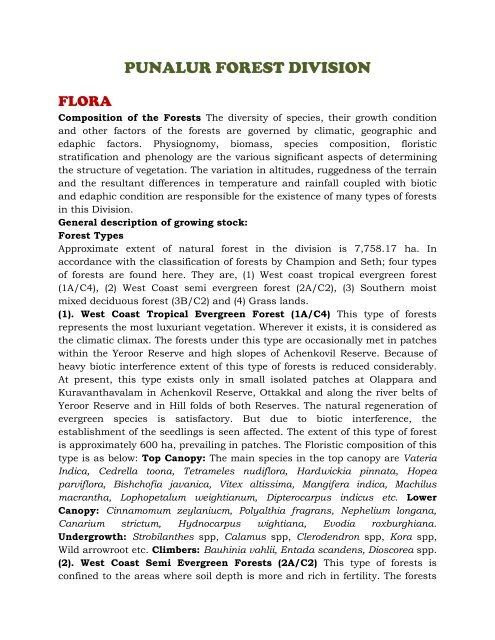
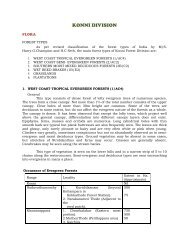
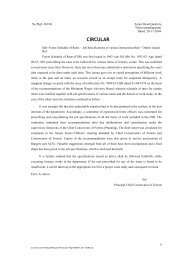
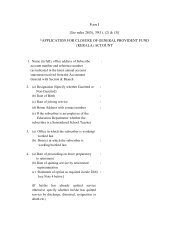
![[See rules 14 & 37(1)] FORM OF APPLICATION FOR TEMPORARY ...](https://img.yumpu.com/49611345/1/190x245/see-rules-14-371-form-of-application-for-temporary-.jpg?quality=85)
